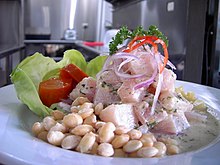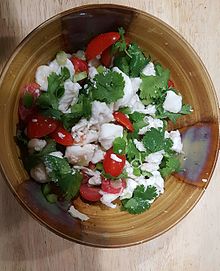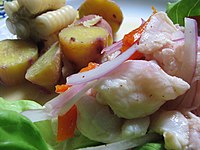food.wikisort.org - Dish
Ceviche[3][4] (Spanish pronunciation: [seˈβitʃe]) is a South American seafood dish originally from what is the modern day countries of Peru, Ecuador and Chile, typically made from fresh raw fish cured in fresh citrus juices, most commonly lime or lemon. It is also spiced with ají, chili peppers or other seasonings and julienned red onions, salt, and cilantro are also added. The name originates from the Quechuan word siwichi, which means fresh or tender fish.[5]
 Ceviche | |
| Course | Main course, appetizer |
|---|---|
| Place of origin | modern-day Peru[1][2] |
| Region or state | South America |
| Serving temperature | Cold; cured with lime juice |
| Main ingredients | Fish, lime, lemon, onion, chili pepper, cilantro |
Because the dish is eaten raw, and not cooked with heat, it must be prepared fresh and consumed immediately to minimize the risk of food poisoning.[6] Ceviche is often eaten as an appetizer; if eaten as a main dish, it is usually accompanied by side dishes that complement its flavors, such as sweet potato, lettuce, maize, avocado, or cooking banana.[7][8][9]
The dish is popular in the Pacific coastal regions of western South America.[10] The origin of ceviche is ancient Incan which today corresponds to the modern day country of Peru and Ecuador.[7] The technique of macerating raw fish and meat in vinegar, citrus, and spices (escabeche) was brought to the Americas from Spain and is linked to the Muslim heritage in Spanish cuisine. However, archeological records suggest that something resembling ceviche may have been in the western South America as early as 2,000 years ago.[7] The dominant position Lima held through four centuries as the capital of the Viceroyalty of Peru allowed for popular dishes such as ceviche to be brought to other Spanish administrative provinces in the region, and in time they became a part of local cuisine by incorporating regional flavors and styles.[11]
Etymology
The first documented evidence of the term ceviche is from 1820, in the song "La Chicha", sung by Peruvian soldiers.
According to the Royal Spanish Academy, the word has the same etymology as the Spanish term escabeche, which derives from Mozarabic izkebêch, in turn descending from Andalusian Arabic assukkabáǧ, which also derives from Classical Arabic sakbāj (سكباج, meaning meat cooked in vinegar).[12][13] It is ultimately from the unattested Middle Persian *sikbāg, from sik ("vinegar")[14] and *bāg ("soup"), which also yielded the Persian word sekbā (سکبا, a soup made with meat and vinegar).[15] Other hypotheses include that it derives from the Quechua word siwichi, meaning fresh fish.[6]
The name of the dish is spelled variously as cebiche, ceviche, seviche, or sebiche, but the most common spelling is ceviche with v, which is an alternative spelling accepted by the Royal Spanish Academy.[3][4] There are also other local variants of the name, including cerbiche and serviche.[9]
History
Various explanations of ceviche's origin exist, with Peruvian nationalists favoring a Pre-Hispanic origin. According to some historic sources from Peru, the predecessor of ceviche originated among the Moche, a coastal civilization that began to flourish in the area of current-day northern Peru and southern Ecuador nearly 2000 years ago.[7][16] In El Salvador, ceviche is a second favorite dish. This tropical country provides a variety of ceviche choices such as shrimp, fish, octopus and black clam ceviche. The recipe is very simple and includes Roma tomatoes, onion, cilantro, lime juice, salt and pepper. The Moche apparently used the fermented juice from the local banana passionfruit.[7] Recent investigations further show that during the Inca Empire, fish was marinated with chicha, an Andean fermented beverage. Different chronicles also report that along the Peruvian coast prior to the arrival of Spaniards, fish was consumed with salt and ají.[16]
Nevertheless, most historians agree that ceviche originated during colonial times in present-day Peru and Ecuador.[17][18] They propose that the predecessor to the dish[specify] was brought to the area by Andalusian women of Moorish background who accompanied the Conquistadors and that this dish eventually evolved into what nowadays is considered ceviche.[18][19] The Peruvian chef Gastón Acurio further explains that the dominant position that Lima held throughout four centuries as the capital of the Viceroyalty of Peru allowed for popular dishes such as ceviche to be brought to other Spanish colonies in the region and to eventually become a part of local cuisine by incorporating regional flavors and styles.[11]
The Peruvian origin of the dish is supported by chefs including the Chilean Christopher Carpentier and the Spaniard Ferran Adrià, who in an interview stated, "Cebiche was born in Peru, and so the authentic and genuine [cebiche] is Peruvian."[20][21]
The different stories that exist about the origin of the ceviche, we only know that it is Peru and Ecuador the two countries that dispute this denomination, perhaps because they were the ones that were influenced by the Incas; however, the first recipe of this dish deserves to Manual Atanasio Fuentes in “The Guide of Lima”. [22]
Preparation and variants
Ceviche is marinated in a citrus-based mixture, with lemons and limes being the most commonly used. In addition to adding flavor, the citric acid causes the proteins in the seafood to become denatured, appearing to be cooked. Acid marinades will not kill bacteria or parasitic worms, unlike the heat of cooking. Traditional-style ceviche was marinated for about three hours. Modern-style ceviche, popularized in the 1970s, usually has a very short marinating period. With the appropriate fish, it can marinate in the time it takes to mix the ingredients, serve, and carry the ceviche to the table.[23]
Most Latin American countries have given ceviche its own touch of individuality by adding their own particular garnishes.
- Peruvian ceviche
- Ecuadorian ceviche, made of shrimp, lemon and tomato sauce
- Mexican ceviche
- Ceviche from Costa Rica
South America
In Peru, ceviche has been declared to be part of the country's national heritage and has even had a holiday declared in its honor.[24] The classic Peruvian ceviche is composed of chunks of raw fish, marinated in freshly squeezed key lime, with sliced onions, chili peppers, salt and pepper. Corvina or cebo (sea bass) was the fish traditionally used. The mixture was traditionally marinated for several hours and served at room temperature, with chunks of corn on the cob and slices of cooked sweet potato. Regional or contemporary variations include garlic, fish bone broth, minced Peruvian ají limo, or the Andean chili rocoto, toasted corn or cancha and yuyo (seaweed). A specialty of Trujillo is ceviche prepared from shark (tollo or tojo). Lenguado (sole) is often used in Lima. The modern version of Peruvian ceviche, which is similar to the method used in making Japanese sashimi, consists of fish marinated for a few minutes and served promptly. It was developed in the 1970s by Peruvian-Japanese chefs, including Dario Matsufuji and Humberto Sato.[25] Many Peruvian cevicherías serve a small glass of the marinade, which is called leche de tigre or leche de pantera, as an appetizer along with the fish.
In Ecuador, shrimp ceviche is sometimes made with tomato sauce for a tangy taste. The Manabí style, made with lime juice, salt and the juice provided by the cooked shrimp itself, and sometimes topped with peanut butter, is very popular. Occasionally, ceviche is made with various types of local shellfish, such as black clam (cooked or raw), oysters (cooked or raw), spondylus (raw), barnacles (cooked percebes), among others mostly cooked. It is served in a bowl with toasted corn kernels as a side dish; fried green plantain chunks called "patacones", thinly sliced plantain chips called chifle, and popcorn are also typical ceviche side dishes. In some regions, ceviche is served with rice on the side. Well cooked sea bass (corvina), octopus, and crab ceviches are also common in Ecuador. In all ceviches, onion, lime juice, cilantro and salt are ubiquitous ingredients.[26]
In Chile, ceviche is often made with fillets of halibut or Patagonian toothfish[27] and marinated in lime and grapefruit juices; finely minced garlic and red chili peppers[28] and often fresh mint and cilantro are added.[29] On Easter Island, the preferred fish is tuna, marinated in lemon juice and coconut milk.
North and Central America and the Caribbean

In Mexico, the U.S., and some parts of Central America, it is served either in cocktail cups with tostadas, or as a tostada topping and taco filling. In Mexico, when served in a cup with tomato sauce, it is called a ceviche cocktail. Shrimp, octopus, squid, tuna, and mackerel are also popular bases for Mexican ceviche. The marinade ingredients include salt, lime, onion, chili peppers, avocado, and cilantro (coriander). Cut olives and tomatoes are often added to the preparation.
In El Salvador and Nicaragua one popular ceviche recipe is ceviche de concha negra ("black conch ceviche"), known in Mexico as pata de mula ("mule's foot"). It is dark, nearly black, with a distinct look and flavor. It is prepared with lime juice, onion, yerba buena, salt, pepper, tomato, Worcestershire sauce, and sometimes picante (any kind of hot sauce or any kind of hot pepper) as desired.
In Nicaragua and Costa Rica, the dish includes marinated fish, lime juice, salt, ground black pepper, finely minced onions, cilantro, and finely minced peppers. It is usually served in a cocktail glass with a lettuce leaf and soda crackers on the side, as in Mexico. Popular condiments are tomato ketchup, mayonnaise, and Tabasco sauce. The fish is typically tilapia or corvina, although mahi-mahi, shark and marlin are also popular.
In Panama, ceviche is prepared with lemon juice, chopped onion, celery, cilantro, assorted peppers, and sea salt. Ceviche made with corvina (white sea bass) is very popular and is served as an appetizer in most local restaurants. It is also commonly prepared with octopus, shrimp, and squid, or served with small pastry shells called "canastitas."
In the Caribbean, ceviche is often made using mahi-mahi prepared with lime juice, salt, onion, green pepper, habanero, and a touch of allspice. Squid and tuna are also popular. In Puerto Rico and other places in the Caribbean, the dish is prepared with coconut milk. In the Bahamas and south Florida, a conch ceviche known as conch salad is very popular. It is prepared by marinating diced fresh conch in lime with chopped onions, and bell pepper. Diced pequin pepper or Scotch bonnet pepper is often added for spice. In south Florida, it is common to encounter a variation to which tomato juice has been added.
Health risks
Bad sanitary conditions in its preparation may lead to illness. Aside from contaminants, raw seafood can also be the vector for various pathogens, viral and bacterial, as well as larger parasitic creatures.[30][31] According to the United States Food and Drug Administration and studies since 2009, specific microbial hazards in ceviche include Anisakis simplex, Diphyllobothrium spp., Pseudoterranova decipiens and Pseudoterranova cattani, and Vibrio parahaemolyticus.[32][33] Anisakiasis is a zoonotic disease caused by the ingestion of larval nematodes in raw seafood dishes such as ceviche.[34][35] The Latin American cholera outbreaks in the 1990s may have been attributed to the consumption of raw cholera-infested seafood that was eaten as ceviche.[36]
The American Dietetic Association urges women to avoid ceviche during pregnancy due to the health risks it introduces if not prepared properly.[37]
See also
- Boquerones en vinagre – Anchovy tapa appetizer marinated in vinegar, garlic and parsley eaten in Spain
- Escabeche – Ibero-American fish or meat dish, cooked or raw fish or meats in an acidic marinade
- Kinilaw – Filipino seafood dish, sometimes referred to as "Philippine ceviche"
- List of raw fish dishes
- List of fish dishes
References
- "¡Orgullo peruano! Conoce la historia del cebiche y sus deliciosas variantes regionales". Archived from the original on 2021-10-28. Retrieved 2021-08-16.
- "Ladyfinger". 22 September 2021.
{{cite web}}: CS1 maint: url-status (link) - "cebiche". Diccionario de la Lengua Española. Real Academia Española. Archived from the original on August 10, 2017. Retrieved August 28, 2013.
- "sebiche". Diccionario de la Lengua Española. Real Academia Española. Archived from the original on November 10, 2013. Retrieved August 28, 2013.
- "Descubre el origen del Cebiche, uno de los potajes más "trendys" y aclamados". Archived from the original on 2021-12-26. Retrieved 2021-08-16.
- Benson et al. Peru p. 78
- "Perú decreta el 28 de junio como el Día del Seviche". El País Internacional (in Spanish). Lima: Ediciones El País, S.L. September 19, 2008. Archived from the original on October 26, 2016. Retrieved August 28, 2013.
- Rodriguez, The Great Ceviche Book, pp. 5-10
- Harrison, Beyond Gumbo, p. 85
- González and Ross, Entre el comal y la olla: fundamentos de gastronomía costarricense, p. 171
- Revolución de los gustos en el Perú pp. 80-81
- "sebiche". Diccionario de la Lengua Española. Royal Spanish Academy. Archived from the original on 2012-02-13. Retrieved 2010-08-09.
- Hans Wehr, Arabic–English Dictionary. Otto Harrassowitz KG: 1994. Page 486
- "sik" in David Neil MacKenzie (1986), A Concise Pahlavi Dictionary, London: Oxford University Press, ISBN 0-19-713559-5
- سکبا in Dehkhoda Dictionary
- Zapata Acha, Sergio (November 2006). Diccionario de gastronomía peruana tradicional (in Spanish) (1st ed.). Lima, Perú: Universidad San Martín de Porres. ISBN 9972-54-155-X.
- Rodriguez, The Great Ceviche Book, p. 3
- Peschiera, Cocina Peruana, p. 35
- Ariansen Cespedes, Jaime. "La facinante historia del Cebiche". Mito, Leyenda y Folklore en la Gastronomia Peruana VI (in Spanish). Instituto de los Andes. Archived from the original on August 5, 2018. Retrieved August 28, 2013.
- "Los cocineros peruanos realizan un magnífico trabajo". LaRepublica.pe (in Spanish). Perú. August 14, 2011.
- "Chef chileno reconoció que causa, cebiche y pisco sour son peruanos". elcomercio.pe. 2011. Archived from the original on 4 August 2011. Retrieved 14 August 2011.
- "The Peruvian ceviche and the history that made it a Cultural Patrimony of the Nation | Pisac Inn". pisacinn.com.
- "Peruvian cuisine. What food do they eat in Peru?". Travel Food Atlas. Archived from the original on 2018-09-15. Retrieved 2018-03-24.
- "Peru this Week". Livinginperu.com. Archived from the original on 2010-07-12. Retrieved 2013-08-25.
- Solari, Carola (11 January 2010). "Peruano + japonés". Paula.cl. Archived from the original on 17 August 2014. Retrieved 15 March 2013.
- Duarte-Casar, Rodrigo; Robalino-Vallejo, Jessica; Buzetta-Ricaurte, María Fernanda; Rojas-Le-Fort, Marlene (12 May 2022). "Toward a characterization of Ecuadorian ceviche: much more than shrimp". Journal of Ethnic Foods. 9 (1): 16. doi:10.1186/s42779-022-00131-w. S2CID 248725703.
- "Chilean Ceviche". Archived from the original on 2009-11-16. Retrieved 2010-08-09.
- "Chilean Ceviche'". The Gutsy Gourmet. Archived from the original on May 24, 2013. Retrieved August 28, 2013.
- Randhawa, Jessica (May 2, 2019). "Chilean Ceviche". theforkedspoon.com/. Archived from the original on July 22, 2020. Retrieved November 20, 2019.
- "Parasites in Marine Fishes". Seafood Network Information Center – Sea Grant Extension Program. National Oceanic and Atmospheric Administration. Archived from the original on September 27, 2011. Retrieved August 28, 2013.
- "Doctor's Responses". parasites from sushi – abdominal pain & dairrrhea article. MedicineNet, Inc. Archived from the original on November 14, 2012. Retrieved August 28, 2013.
- "FDA". Food and Drug Administration. Archived from the original on February 27, 2013.
- Weitzel, Thomas; Sugiyama, Hiromu; Yamasaki, Hiroshi; Ramirez, Cristian; Rosas, Reinaldo; Mercado, Rubén (2015). "Human Infections with Pseudoterranova cattani Nematodes, Chile". Emerging Infectious Diseases. 21 (10): 1874–5. doi:10.3201/eid2110.141848. PMC 4593429. PMID 26402377.
- Sakanari, J. A.; McKerrow, J. H. (July 1989). "Anisakiasis". Clinical Microbiology Reviews. American Society for Microbiology. 2 (3): 278–284. doi:10.1128/CMR.2.3.278. ISSN 1098-6618. PMC 358121. PMID 2670191.
- "Factors that played a role in cholera's resurgence". Publications: People & Ecosystems: World Resources 1998–99. World Resources Institute. Archived from the original on 2010. Retrieved August 28, 2013.
- Benjamin Reilly, Disaster and Human History: Case Studies in Nature, Society and Catastrophe. McFarland: 2009. Page 351
- "Food Safety Risks for Pregnant Women and Newborns". eatright.org: Public. Academy of Nutrition and Dietetics. December 2012. Archived from the original on September 6, 2015. Retrieved August 28, 2013.
Bibliography
- Bayless, Rick (2000). Mexico One Plate at aTime. Simon & Schuster. ISBN 0-684-84186-X.
- Butler, Cleora (2003). Cleora's Kitchens: The Memoir of a Cook and Eight Decades of Great American Food. Council Oak Books, LLC. ISBN 1-57178-133-1.
- "Revolución de los gustos en el Perú". Américas. General Secretariat of the Organization of American States. June 2006. ISBN 9780071596602.
- González, Marjorie Ross; Ross, Marjorie (2001). Entre el comal y la olla: fundamentos de gastronomía costarricense. Euned. ISBN 9789968311281.
- Harris, Jessica B. (2003). Beyond gumbo: Creole fusion food from the Atlantic Rim. Simon & Schuster. ISBN 0-684-87062-2.
- Meyer, Arthur L.; Vann, Jon M. (2003). The Appetizer Atlas: A World of Small Bites. John Wiley and Sons. ISBN 0-471-41102-7.
- Peschiera, Emilio (2005). Cocina Peruana. Ediciones Granica S.A. ISBN 956-8077-30-8.
- Presilla, Maricel (2012). Gran Cocina Latina. W. W. Norton & Company. p. 479. ISBN 978-0-393-05069-1.
- Rodriguez, Douglas (2010-06-08). The Great Ceviche Book. Ten Speed Press. p. 3. ISBN 978-1-58008-107-8.
На других языках
- [en] Ceviche
[es] Cebiche
El cebiche, ceviche, sebiche o seviche (todas válidas y todas incluidas en el Diccionario de la lengua española; cada una se usa en una zona geográfica diferente)[1] es un plato consistente en carne marinada ―pescado, mariscos o ambos― en aliños cítricos. Diferentes versiones del cebiche forman parte de la cultura culinaria de diversos países hispanoamericanos litorales del océano Pacífico[2] de donde cada una es nativa: Chile, Colombia, Costa Rica, Ecuador, El Salvador, Guatemala, Honduras, México, Nicaragua, Panamá y Perú. En este último se lo considera como patrimonio cultural.[3][ru] Севиче
Севи́че (себиче, исп. ceviche, cebiche, seviche или sebiche) — блюдо из рыбы или морепродуктов, родиной которого считается Перу[2][3]. Блюдо получило распространение в кухнях многих латиноамериканских стран, хотя рецепты могут разниться значительно. Например, в Колумбии при приготовлении блюда используется томатная паста или кетчуп.Другой контент может иметь иную лицензию. Перед использованием материалов сайта WikiSort.org внимательно изучите правила лицензирования конкретных элементов наполнения сайта.
WikiSort.org - проект по пересортировке и дополнению контента Википедии



